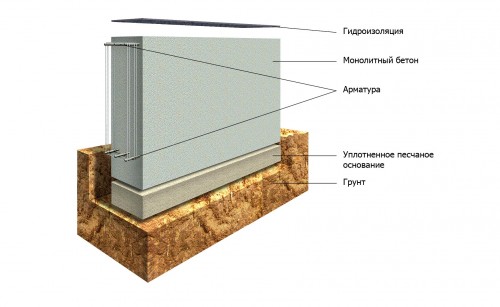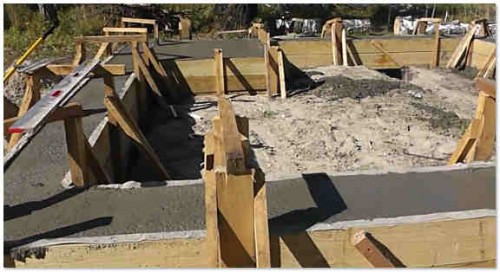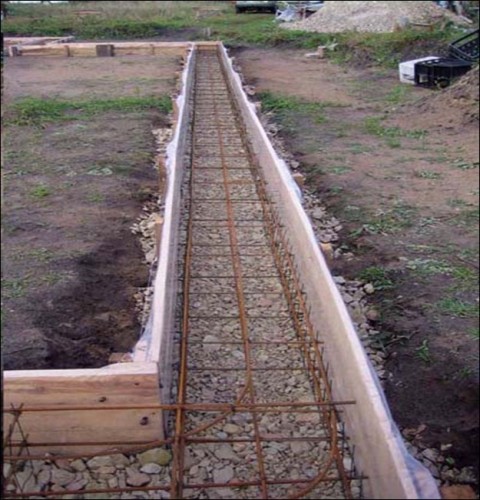The use of a classic deep laying foundation in the construction of low-rise light structures justifies itself by 15-20%. That is, the means spent on laying such a foundation during the construction of small brick or stone buildings will be wasted.
Content
For such cases, it is better to use the foundation of the small -sized strip. This is a concrete tape that fits directly into the freezing soil layers half a meter higher than groundwater for all the supporting walls of the building.
Types of strip foundation
- Made.
- Monolithic.
The assembly foundation involves laying ready-made iron-concrete slabs of standard sizes in the trench, and their connection with each other through a cement mortar. This method is suitable for construction projects in a short time. After all, laying such a foundation, do not wait for his hardening and shrinkage. However, here it is required to attract a lifting crane. In addition, this method is not appropriate in case of non -standard wall sizes. Therefore, this method of laying the foundation is not as popular as the next.
The monolithic foundation is made directly on the construction site by pouring concrete in a prepared trench. The production of such a foundation is more time -consuming and requires much greater cost of labor. But, but, the foundation will be even and perfectly fill the cavity of the ditch.
The depth of the fine-sized tape foundation, as it is already clear from the name, is small (0.5-0.8 m), in comparison with the usual deep-laying foundation (1.5-1.8 m). The strip fine-toed foundation is much more simple in arrangement than the foundation of plates or piles, but its price will be higher due to the volume of the material used.
The fine -sized strip foundation on the slope is not the best option. This type of laying, of course, will solve many technical problems, but it will be very expensive to cost. This option is good for fairly wealthy developers.
Benefits
- The cost of a finely small-sized foundation is 3-4 times lower than the cost of a deep-laying foundation.
- Significant costs of effort and time for the installation of a tape fine -toed foundation compared to the standard analogue.
- The ability to arrange a small basement in the house.
- This type of foundation is less amenable to deformations associated with soil movements.
Disadvantages of the striped foundation tape
- This type of foundation is suitable only for light low buildings.
-
It is combined only with soils that are not very swollen.
-
A prerequisite for the use of this technology is a low arrangement of groundwater.
-
The need for a thorough organization of water disposal system to protect the basis from precipitation.
With your own hands
What will be needed
- Crushed stone.
- Cement.
- Sand.
- Brick.
- Water.
- Metal rods for reinforcing with a diameter of 10 mm and 15-16 mm.
- Bars made of wood.
- Stakes and struts.
- Rolling roofing material.
- Foam polypropylene, fiberglass or agril.
- Boards stuck on one side.
- Geotextiles.
- Construction level.
- Excavator.
Modeling technology of shallow tape foundation
-
Clean the working area of \u200b\u200bgarbage and weeds.
- Mark the future trench with a rope and pegs.
- Dig a trench about 0.7 m in width and the same in the depths. So that loose soil does not fall along the edges, form slopes.
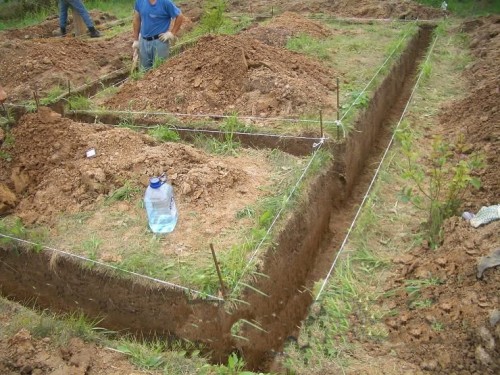
- Pour the sand with a layer of 0.2-0.4 m on its bottom (this layer will serve as a kind of shock absorber when temperatures and humidity levels).
- Moisten the sand and compact.
- Pull the spacers and stake around the perimeter of the ditch.
- Strengthen the boards on them, eager to build the formwork.
- Check the correct placement of wooden shields using the building level.
- The internal surfaces of the blind area isolate with roofing material.
- Pour the starting layer of concrete 0.1-0.15 cm.
- Build a reinforcing frame from metal rods in the shape of a trench, leaving a gap between the longitudinal rods and the foundation plane in order to exclude corrosion. The rods of the frame can be stuck with a special knitting wire or welding.
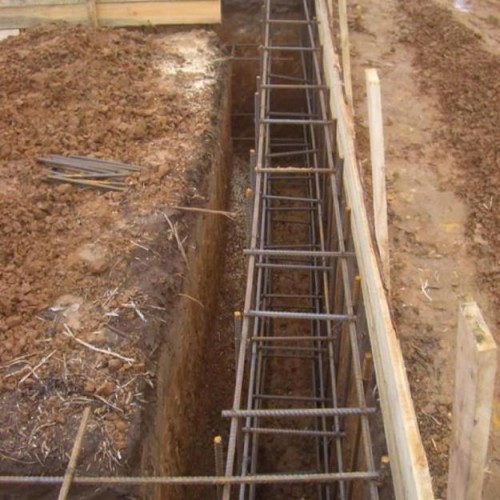
- Pour concrete in layers of 0.2 m, compaction of each of them in order to exclude the possibility of the formation of voids inside the array.
- Pour the sinuses with sand.
It is important to know!
- A competent organization of the water disposal system when arranging such a foundation is of great importance.
- After pouring the foundation, its surface must be covered with a film. So you can avoid cracks in the future.
- The blind area that is made after pouring the foundation is certainly needed.
- High -quality concrete is the key to a high -quality foundation, do not try to save here.
- The embedded foundation should not winter open. Construction work, if possible, should be assured before frost. If this is not possible, then it is necessary to “cover” the foundation with sawdust, expanded clay, etc. Materials that can reduce the effect of temperature changes.
Shallow tape foundation on clay
- The creation of the foundation of this type on clay heaving soils is characterized by a number of problems dictated by the unstable properties of clay. In this case, it is necessary to carefully equip the drainage system. The implementation of this stage occurs after digging the trench.
- Ride two wells at a distance of 2-3 m from each other. Their depth should not be less than the depth of freezing of the soil.
- Insert the pipes into the wells.
- Fill the voids in the pipes with gravel.
- Pour the bottom of the trench with gravel.
- Pour the areas around the pipes with sand, thoroughly tamping it.
- Cover the surface of the sand crushed stone.
- Set the shields of formwork and reinforcement.
- Pour the concrete mixture.
- Outside the structure, digging another trench to the crushed stone layer of the foundation.
- Pour a new trench with gravel.
- Store a blind area with a width of 0.5-1 m.
Nuance! The pipe can replace, rolled into a roll, any non -wagging material (fiberglass, polypropylene foam, agril, etc.)
Thus, the water of atmospheric precipitation will be displayed in gravelly backfill, and then into drainage pipes. The foundation itself will be in contact with the backfill of dry crushed stone and, as a result, will not swell during the freezing of the soil.
You can find out more about what the foundation is finely fine -toed from the video:

